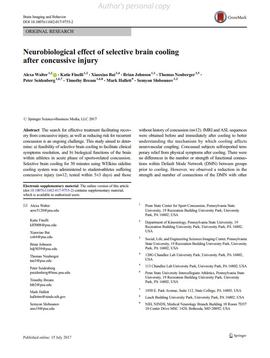|
Research out of Penn State Center for Sport Concussion shows potential benefit of targeted head cooling for athletic concussion  “Currently there are no clinically validated tools or procedures to treat concussive injury,” said Semyon Slobounov, professor of kinesiology and an author of the studies. “The results of these studies provide some preliminary evidence that concussive brains may benefit from science-based treatment, such as brain cooling and the use of a new supplement.” The study used Welkins' FDA-cleared cooling system to explore the biological effects of lowering temperature on brain injuries in athletes. Athletes in the acute phase of injury, or within seven to 10 days of diagnosis, underwent functional MRI and arterial spin labeling testing – an MRI technique for measuring blood flow in tissues – before and after using the cooling device. After cooling, concussed subjects reported temporary relief of concussion symptoms such as dizziness, nausea, concentration and memory difficulties. Researchers also noted increases in cerebral blood flow, or blood flow to the brain, after cooling was applied. “This study suggests that compromised brain functioning in the acute phase of injury could be temporarily restored with brain cooling,” Slobounov said. AbstractThe search for effective treatment facilitating recovery from concussive injury, as well as reducing risk for recurrent concussion is an ongoing challenge. This study aimed to determine: a) feasibility of selective brain cooling to facilitate clinical symptoms resolution, and b) biological functions of the brain within athletes in acute phase of sports-related concussion. Selective brain cooling for 30 minutes using WElkins sideline cooling system was administered to student-athletes suffering concussive injury (n=12; tested within 5±3 days) and those without history of concussion (n=12). fMRI and ASL sequences were obtained before and immediately after cooling to better understanding the mechanism by which cooling affects neurovascular coupling. Concussed subjects self-reported temporary relief from physical symptoms after cooling. There were no differences in the number or strength of functional connections within Default Mode Network (DMN) between groups prior to cooling. However, we observed a reduction in the strength and number of connections of the DMN with other ROIs in both groups after cooling. Unexpectedly, we observed a significant increase in cerebral blood flow (CBF) assessed by ASL after selective cooling in the concussed subjects compared to the normal controls. We suggest that compromised neurovascular coupling in acute phase of injury may be temporarily restored by cooling to match CBF with surges in the metabolic demands of the brain. Upon further validation, selective brain cooling could be a potential clinical tool in the minimization of symptoms and pathological changes after concussion. For more information, visit the Penn State Center for Sport Concussion Research and Service and check out the study published in Brain Imaging and Behavior.
Comments are closed.
|

 RSS Feed
RSS Feed
